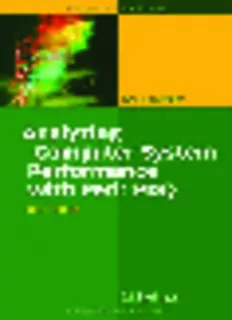
Analyzing computer system performance with Perl:PDQ PDF
Preview Analyzing computer system performance with Perl:PDQ
Analyzing Computer System Performance with Perl::PDQ Neil J. Gunther Analyzing Computer System Performance w ith Perl::PDQ Second Edition Neil J. Gunther Performance Dynamics Company 4061 East Castro Valley Boulevard Castro Valley, CA 94552 USA http://www.perfdynamics.com/ ISBN 978-3-642-22582-6 e-IS BN 978-3 -642-22583-3 DOI 10 .1007/978-3-642-22583-3 Springer Heidelberg Dordrecht London New York Library of Congress Control Number: 2011934511 ACM Codes: C.0, C.2.4, C.4, D.2.5, D.2.8, D.4.8, K.6.2 ©© Springer-Verlag(cid:0)B erlinHeidelberg2005, 2011 This work is subject to copyright. All rights are reserved, whether the whole or part of the material is concerned, specifically the rights of translation, reprinting, reuse of illustrations, recitation, broadcasting, reproduction on microfilm or in any other way, and storage in data banks. Duplication of this publication or parts thereof is permitted only under the provisions of the German Copyright Law of September 9, 1965, in its current version, and permission for use must always be obtained from Springer. Violations are liable to prosecution under the German Copyright Law. The use of general descriptive names, registered names, trademarks, etc. in this publication does not imply, even in the absence of a specific statement, that such names are exempt from the relevant protective laws and regulations and therefore free for general use. Coverd esign: KünkelLopka Printedonacid-freepaper SpringerispartofSpringerScience+BusinessMedia(www.springer.com) This book is dedicated to the memory of my father Walter August Gunther, MIEAust, CPEng October 23, 1908 – November 16, 2010 Preface to Second Edition What’s New? It seems fitting that this new edition appears as we pass the centenary of the original paper by Erlang [1909], where he first introduced the concept of a queue. This edition incorporates a considerable number of new features compiled since the publication of the first edition in 2005. New Chapters and Partitioning The amount of additional material means the book now comprises four parts instead of three. In particular, Part I contains new chapters that present a more complete discussion of the underlying concepts used throughout this book. Improved Perl Formatting All listings have a highlighted format to aid readability of PDQ codes. Listing 1. Example of the new PDQ code format #! /usr/bin/perl use pdq; pdq::Init("Example"); pdq::CreateNode($NodeName, $pdq::CEN, $pdq::FCFS); pdq::CreateOpen($WorkName, $ArrivalRate); pdq::SetDemand($NodeName, $WorkName, $ServiceDemand); pdq::Solve($pdq::CANON); pdq::Report(); viii Preface to Second Edition Virtualization AnewChapter13:VirtualMachineAnalysiswithPDQ,inPartIII,presentsqueue- ing models of fair-share scheduling that underpins all modern virtual machine im- plementations from hyperthreading to cloud computing. PDQ on SourceForge All PDQ development is now gated through SourceForge sourceforge.net/ projects/pdq-qnm-pkg/ under the title Pretty Damn Quick Queueing Model Package. PDQ can also be downloaded from the author’s distribution page at www.perfdynamics.com/Tools/PDQcode.html. Why Queues Rule A new Chapter 1: Why Queues Rule Performance Analysis, endeavors to explain whyqueueingmodelsaresopowerfulfordoingcomputerperformanceanalysis.See Example1.2whichpresentsaPDQperformanceandcapacitymodelofserversthat are dedicated to filtering email spam. PDQ Manual PartIVcomprisesasetofappendices.IncludedthereisthePDQManualwhichhas been broken out from its previous inclusion in the chapter: Pretty Damn Quick— A Slow Introduction. Updates are available online at www.perfdynamics.com/ Tools/PDQman.html. CreateMultiNode Function ThelatestreleaseoftheopensourcePDQcodenowimplementsmulti-serverqueue- ing nodes. See Appendix D.3.2 for details. Brief History of Buffers ThepottedhistoryofqueueingtheoryentitledA Brief History of Buffers,thatwas previously isolated as a separate Appendix, has been updated and now appears at the end of the new Chapter 1. Performance Management Tools The Appendix on performance management tools in the first edition has now been expanded in a new Chapter 2. Scalability and Queueing A new Section 4.11.12 in Chapter 4 shows how the author’s universal scalability law (developed in the book Guerrilla Capacity Planning [Gunther 2007b]) is re- lated to the queueing models presented in this book, viz., the machine repairman model [Gunther 2008]. Preface to Second Edition ix Jackson’s Theorem Chapter 5 contains a new section explaining the importance of Jackon’s theorem for circuits of queues. This concept is vital for constructing performance models of modern multi-tier applications, such as those employed at large-scale web sites. Glossary Removed The Glossary in the first edition became outdated and has been removed in order to accommodate the new chapter content without unduly increasing the size of the entire book. Crowd-sourced Corrections Thecorrigendaatwww.perfdynamics.com/iBook/ppdqerrata.htmlisates- tamenttothepoweroftheinternetforenablingmanyeyestospottyposanderrors. Every effort has been made to include all the listed errata in this edition. Acknowledgments Phil Feller masterfully applied SWIG (www.swig.org/) to the PDQ function C library in order to programmatically convert it to Perl. Stefan Parvu championed the use of PDQ in the field and provided important feedback for Section 4.11.12. TheperformancegroupatVMwareInc.,contributedtosomeveryusefuldiscussions that helped to shape Chap. 13. Once again, I am endebted to the alumni of Performance Dynamics Company classes, and other diligent readers, who contributed errata for the first edition at www.perfdynamics.com/iBook/ppdqerrata.html.Inalphabeticalorderthey are: P. Altevogt, D. Anburaj, W. Baeck, T. Becker, E. Borasky L. Braswell, D. Hagler,E.Juan,S.Kannan,M.Marino,P.Puglia,J.Purinton,T.Sych,I.Tegebo, D.Walter,T.Wilson.Inparticular,P.Can˜adilladidatrulyoutstandingjob,ashis recordtallyattests.Ifitthereissuchathingasacopy-editor gene,Ibelievehehas it. Finally, I am grateful to Ralf Gerstner, my editor, for his patience while I searched for fragmented opportunities to update the manuscript during some diffi- cult periods over the past two years. Melbourne, Australia N.J.G. December, 2010 perl -le ‘@q=("\120\145\162\154","\120\104\121"); $s="\115\141\171\040\171\157\165\162\040@q\040\bs\040\142\145"; $q[0]=˜s/e/ea/;$q[0]=lcfirst($q[0]);@q=reverse(@q);$s.=" @q \bs!";print $s‘
Description: